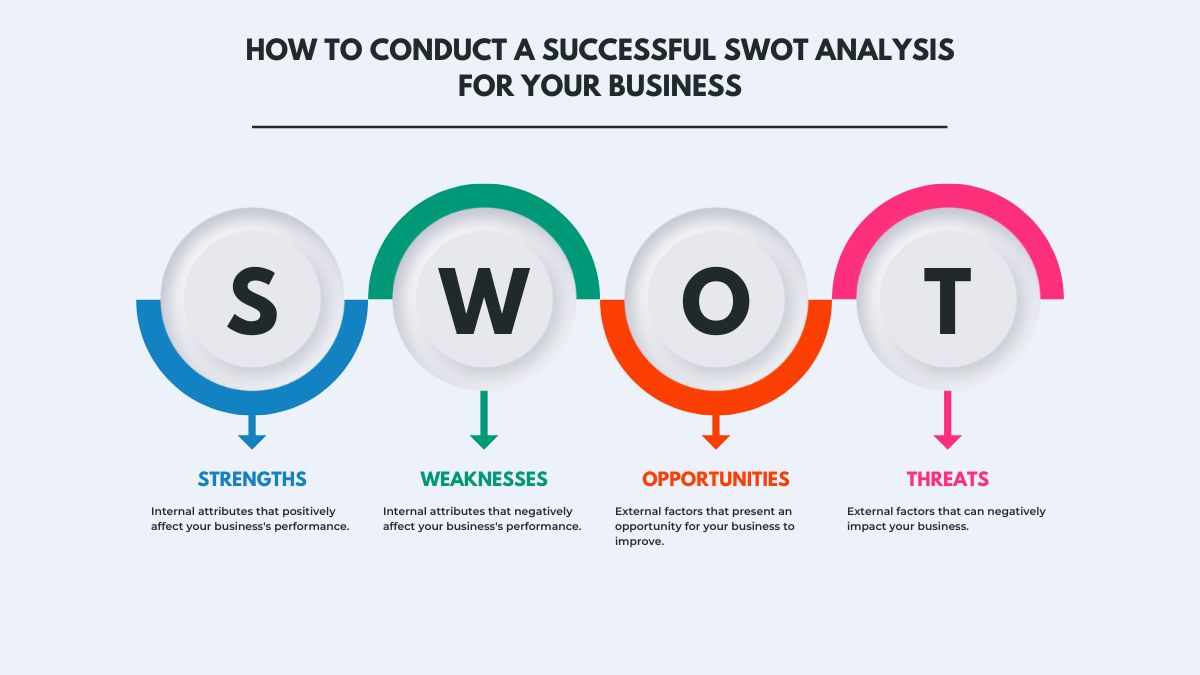
A SWOT analysis is a powerful tool for assessing your business’s current strengths, weaknesses, opportunities, and threats. By conducting a SWOT analysis, you can gain valuable insights into your business’s performance and identify areas for improvement. In this blog post, we’ll discuss how to conduct a successful SWOT analysis for your business.
What is a SWOT Analysis?
A SWOT analysis is a framework used to analyze a company’s current state by assessing its strengths, weaknesses, opportunities, and threats. The analysis can be used to identify areas where a company is excelling and areas where improvements can be made.
SWOT stands for:
- Strengths: Internal attributes that positively affect your business’s performance.
- Weaknesses: Internal attributes that negatively affect your business’s performance.
- Opportunities: External factors that present an opportunity for your business to improve.
- Threats: External factors that can negatively impact your business.
By analyzing these four elements, you can develop a strategic plan that addresses your business’s challenges and leverages its strengths.
Step-by-Step Guide to Conducting a SWOT Analysis
Here are the steps to conduct a successful SWOT analysis for your business:
1. Gather a team:
Organizations rely on strategic planning to make informed decisions and meet their goals. A vital part of the process is the development of a SWOT analysis, which stands for Strengths, Weaknesses, Opportunities, and Threats. Conducting this type of analysis can be challenging for individuals who are unfamiliar with the technique, so organizations must take advantage of every resource available. Gather a team: A SWOT analysis is most effective when conducted with a team of stakeholders, including employees, management, customers, and partners.
When stakeholders from different departments are brought together to conduct a SWOT analysis they bring diverse perspectives and knowledge. This allows the group to identify both internal and external factors that can affect success.
2. Define the objective:
When conducting a SWOT Analysis, it is important to clearly define the objective of your analysis. A SWOT Analysis is an acronym that stands for Strengths, Weaknesses, Opportunities, and Threats. This type of analysis can be used to assess a business or organization’s current state as well as forecast future trends.
To accurately conduct this type of analysis, it is important to establish the objective right away. Is the objective of the SWOT Analysis to analyze the company’s current state? Or will the SWOT Analysis be used in combination with other methods such as market research and financial modeling to forecast future trends? Depending on your goal, different components are necessary for success so you must determine this first.
3. Conduct research:
Conducting a SWOT Analysis is an important step for any business, allowing them to identify their internal strengths and weaknesses, as well as external opportunities and threats. This is a strategic tool used to evaluate a company’s competitive environment, which can help them make decisions about the future of its business. By conducting research into all four areas of the SWOT Analysis – Strengths, Weaknesses, Opportunities, and Threats – businesses can gain better insight into their current situation and be better prepared to face new challenges.
When conducting a SWOT Analysis, it’s important to consider both internal and external factors that could influence your business. Internally this might involve gathering data on the current skillset of employees or examining existing processes in place that may need improvement.
4. Identify strengths and weaknesses:
Conducting a SWOT Analysis can be a great way for businesses to identify their strengths and weaknesses. By taking the time to analyze data and assess the company’s performance, owners can get a better idea of what is working well and where improvements need to be made. Identifying these strengths and weaknesses can help business owners create more effective strategies that target their goals.
Some examples of common strengths include market share, financial resources, customer outreach, brand recognition, and product innovation. Analyzing both internal and external factors allows business owners to determine which areas have the potential for growth or improvement. Additionally, identifying weaknesses is just as important as understanding your company’s strengths; by recognizing areas in need of attention, you can make changes that will lead to success in the future.
5. Identify opportunities and threats:
Conducting a SWOT analysis is an important part of any business strategy. This comprehensive look at the internal and external factors affecting a business can help identify opportunities as well as potential threats. A SWOT analysis looks at the Strengths, Weaknesses, Opportunities, and Threats facing your company. By looking at the external environment, you can gain insight into potential challenges or changes that could have an impact on your success.
When conducting a SWOT analysis for your business, it’s important to consider all aspects of the market in which you are operating. You should analyze changes in consumer preferences and trends, emerging technologies, competition, and economic conditions as they relate to your operations. This can help you identify new markets or products that may be of interest, as well as any risks associated with these areas.
6. Develop a strategic plan:
Conducting a SWOT analysis is an important first step for any business that wants to develop a strategic plan. A SWOT analysis examines the Strengths, Weaknesses, Opportunities, and Threats that exist within a company. By looking at these four factors in depth, businesses can gain valuable insights into their current state and identify areas of improvement.
By leveraging these insights from the SWOT analysis, businesses can create an effective strategic plan that capitalizes on their strengths and corrects weaknesses. This can help them increase efficiency and reach goals faster than ever before. Strategic planning should also consider opportunities to improve products or services as well as potential threats posed by competitors or changes in technology. With this comprehensive understanding of their position in the market, businesses will be able to make informed decisions about their plans.
Examples of Successful SWOT Analyses
Here are a few examples of successful SWOT analyses:
- Tesla: Tesla used a SWOT analysis to identify its strengths in electric vehicle technology and its weakness in manufacturing efficiency. The analysis helped the company develop a strategic plan to increase production and improve its manufacturing processes.
- Coca-Cola: Coca-Cola used a SWOT analysis to identify its strength in brand recognition and its weakness in diversification. The analysis helped the company develop a strategic plan to expand into new markets and diversify its product line.
- Apple: Apple used a SWOT analysis to identify its strength in design and innovation and its weakness in supply chain management. The analysis helped the company develop a strategic plan to improve its supply chain and ensure a consistent supply of its products.
Conclusion
Conducting a SWOT analysis can provide valuable insights into your business’s current state and help you develop a strategic plan for success. By following the steps outlined in this blog post, you can conduct a successful SWOT analysis and identify areas for improvement. Remember to gather a team, clearly define your objective, conduct research, identify strengths and weaknesses, identify opportunities and threats, and develop a strategic plan.




